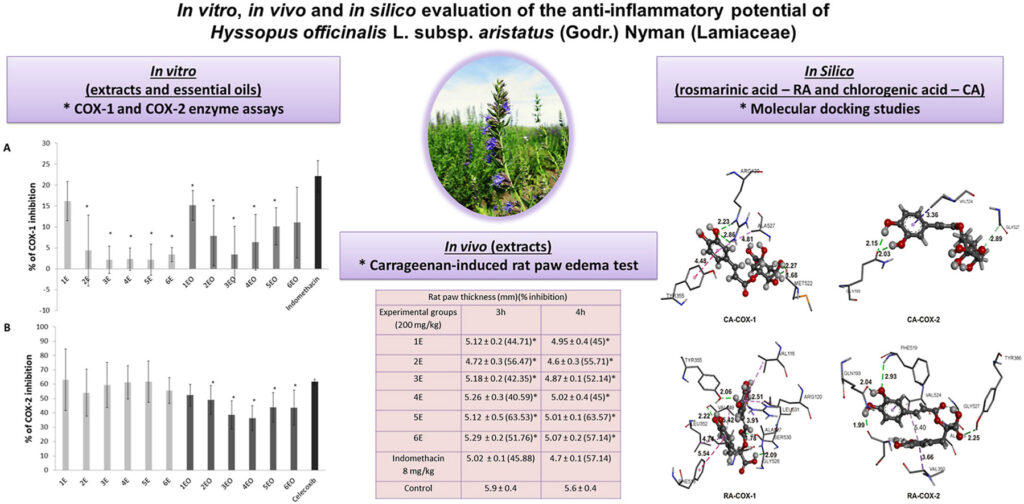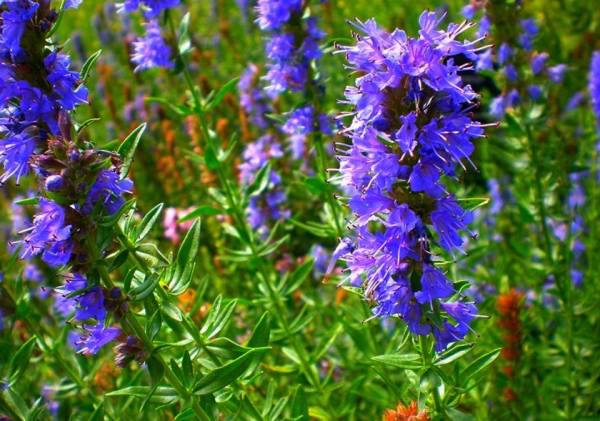Abstract
Ethnopharmacological relevance
Medicinal properties of hyssop have been used in traditional medicine since ancient times, inter alia, in diseases/conditions with an inherent inflammatory process.
Aim of the study: Accordingly, the aim of this study was to investigate the anti-inflammatory properties of hyssop herb preparations (essential oil and methanol extracts) in vivo, in vitro and in silico.
Materials and methods
For in vitro testing of essential oils and extracts of hyssop herb, the cyclooxygenase-1 (COX-1) and cyclooxygenase-2 (COX-2) enzyme assays were used. In vivo anti-inflammatory potential of the extracts (at doses of 50, 100 and 200 mg/kg) was assessed using the carrageenan-induced rat paw edema test. Molecular docking and dynamics were used for in silico testing of the inhibitory activity of chlorogenic (CA) and rosmarinic (RA) acids, as the dominant compounds in the tested methanol extracts against COX-1 and COX-2 enzymes.
Results
Significant inhibitory activity was shown in the COX-2 test regarding extracts (essential oils did not exhibit any significant activity). Namely, all analyzed extracts, at a concentration of 20 μg/mL, showed a percentage of inhibition of COX-2 enzyme (54.04–63.04%), which did not indicate a statistically significant difference from the positive control of celecoxib (61.60%) at a concentration of 8.8 μM. In vivo testing showed that all methanol extracts of hyssop herb, at the highest test dose of 200 mg/kg in the third and fourth hours, after carrageenan administration, exhibited a statistically significant (p < 0.05) inhibitory effect on the increase in rat paw edema in relation to control. This activity is comparable or higher in relation to the reference substance, indomethacin, at a concentration of 8 mg/kg. The preliminary in silico results suggest that investigated compounds (RA and CA) showed better inhibitory activity against COX-1 and COX-2 than standard non-steroidal anti-inflammatory drug (NSAID), ibuprofen, as evident from the free binding energy (ΔGbind in kJ mol−1). The binding energies of the docked compounds to COX-1 and -2 were found to be in the range between −47.4 and −49.2 kJ mol−1. Ibuprofen, as the one NSAID, for the same receptors targets, showed remarkably higher binding energy (ΔGbind = −31.3 kJ mol−1 to COX-1, and ΔGbind = −30.9 kJ mol−1 to COX-2).
Conclusion
The results obtained not only support the traditional use of hyssop herb in inflammatory conditions in folk medicine, but also open the door to and the need for further in vivo testing of extracts in order to examine the molecular mechanism of anti-inflammatory activity in living systems and possibly develop a new anti-inflammatory drug or supplement.
Graphical abstract

Introduction
Inflammation is a protective response of the microcirculation triggered after infection/injury, which aims to eliminate the effects of harmful stimuli (Fullerton and Gilroy, 2016). Inflammatory processes are associated with various acute and chronic diseases (Yang et al., 2017), many of which pose a current problem today such as rheumatoid arthritis, multiple sclerosis, chronic asthma, inflammatory bowel disease, psoriasis, cardiovascular and malignant diseases (Gautam and Jachak, 2009). The prevalence of these diseases, especially obesity, cardiovascular, neurodegenerative diseases, and cancer, has increased rapidly over the past decades (Okin and Medzhitov, 2012).
The main anti-inflammatory drugs are glucocorticoids and nonsteroidal anti-inflammatory drugs (NSAIDs). NSAIDs (aspirin, ibuprofen, naproxen) manifest their activity by inhibiting enzymatic activities of cyclooxygenases-1 and -2 (COX-1 and COX-2), key enzymes in the conversion of arachidonic acid to prostaglandins, most often via non-selective inhibition (Turini and DuBois, 2002). However, due to numerous adverse reactions, which can be serious, especially with long-term use, associated with the use of existing anti-inflammatory drugs, e.g. NSAID: cardiotoxicity and gastrointestinal toxicity (Sinniah et al., 2021); glucocorticoids: osteoporosis, diabetes, hypertension, skin hypertrophy, adrenal suppression, and glaucoma (den Uyl et al., 2011), alternative compounds, which would exhibit a satisfactory anti-inflammatory effect with fewer or no side effects, have been sought. This primarily refers to natural compounds such as plant polyphenols (Pushpa and Mahesh, 2017). Particular problem, in terms of side effects, represents a group of selective COX-2 inhibitors called COXIBs, thus commercially available were celecoxib (Celebrex) and rofecoxib (Vioxx). Many compounds that are selective COX-2 inhibitors have been developed for therapeutic use because they were thought to selectively block inflammation caused by the action of COX-2, without the danger of causing any gastrointestinal problems and side effects by inhibition of the COX-1 enzyme. However, rofecoxib was withdrawn from the market due to a significant increase in cardiac stroke risk (Vonkeman and van de Laar, 2010). This is just one of the reasons for directing the attention of the scientific community towards discovery of new sources of COX-2 inhibitors, with a special focus on plant sources (Katanić et al., 2016; Samardžić et al., 2018; Wang et al., 2013). Many medicinal plants are known for their anti-inflammatory action and are used not only in traditional medicine, but also in conventional therapy. Based on their action, they are also classified in numerous world pharmacopoeias, e.g. Calendula officinalis L., Matricaria chamomilla L., Salvia officinalis L., Achillea millefolum L., etc., have widespread use in treatment of various inflammation-based ailments (Shikov et al., 2014). Of natural products from plant origin, there are several groups of compounds that are carriers of anti-inflammatory effects, e.g., phenolic compounds (phenolic acids, flavonoids, anthocyanins), terpenes, lignans, etc. (Calixto et al., 2003, 2004; Fürst and Zündorf, 2014) detected in medicinal plants of diverse genera. For these purposes, the plant species, which have been found to be effective in inflammatory processes over the years of use in traditional medicine, are first examined. One such plant is hyssop, Hyssopus officinalis L. (Lamiaceae).
Hyssop is a medicinal and aromatic plant, whose medicinal properties have been used in traditional medicine since ancient times. It is also used in the food and cosmetics industry and as a decorative plant. In traditional medicine, it is, inter alia, used for digestive and intestinal disorders, as well as to treat respiratory diseases such as tuberculosis, asthma, chronic catarrh, and bronchitis; it is also valued in the treatment of rheumatic pains, bruises, wounds, burns, frostbite, skin irritation (Judžentienė, 2016; Tucakov, 2010). This herb has been used traditionally as an expectorant, carminative, anti-inflammatory, anti-catarrhal, and antispasmodic medicine in many parts of the world (Srivastava et al., 2018; Vlase et al., 2014). Since ancient times hyssop has been used to treat rheumatic pains, bruises, wounds, etc. (Hajdari et al., 2018). The herb was used to alleviate digestive disorders, cure laryngitis and to accelerate wound healing in folk medicine of different nations. It is used in tea blends for cough relief, antispasmodic effects and relieving catarrh (Srivastava et al., 2018). In Southern Europe, it was used in the treatment of nose, throat, and lung afflictions due to its anti-inflammatory properties. Generally, these therapeutic uses and health benefits of hyssop are largely based on folklore rather than on scientific substantiation (Vlase et al., 2014). There are also literature data speaking in favour of the anti-inflammatory activity of this species; for example, Wang et al. (2011) indicated that the aqueous extract of hyssop herb had a potential to regulate T helper cell differentiation, thus contributing to anti-inflammatory activity. Ma et al. (2014) showed that in vivo application of H. officinalis aqueous extract regulated the levels of eosinophil in bronchoalveolar fluid and immunoglobulin IgG and IgE in serum. H. officinalis was reported not only to exhibit anti-inflammatory activity but also to affect immune regulation (Ma et al., 2014).
Traditional use and previous literature data provide a good basis for testing the anti-inflammatory activity of hyssop herb preparations. There is little scientific evidence on H. officinalis anti-inflammatory activity regarding its impact on cyclooxygenase enzymatic activities and in vivo assessment of anti-inflammatory potential. This study aims to reveal the anti-inflammatory activity of Hyssopus officinalis subsp. aristatus (Godr.) Nyman essential oils and methanolic extracts from the aerial parts of the plant. Namely, the anti-inflammatory activity of methanol extracts and essential oils of hyssop herb was tested in vitro, and then the testing of extracts was continued in vivo; the ability of the dominant compounds of the methanol extracts (chlorogenic and rosmarinic acids) to inhibit the activity of cyclooxygenase-1 and -2 (COX-1 and COX-2) enzymes, was assessed in silico. The results of basic phytochemical analyses of essential oils (gas chromatography-mass spectrometry, GC-MS) and methanol extracts (liquid chromatography with diode array detection and mass spectrometry, LC-DAD-MS), samples used in this study, were reported recently by our research group (Mićović et al., 2021).


